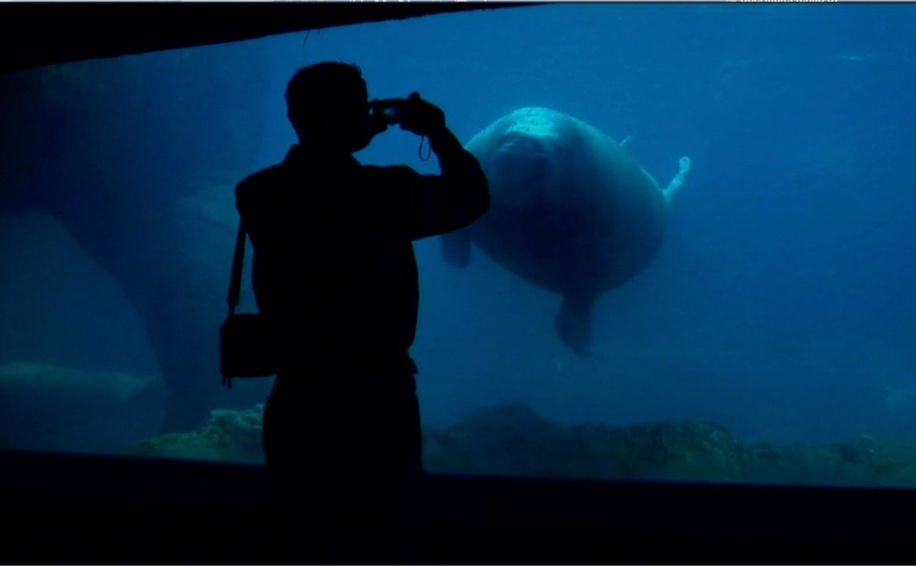Humans try to camouflage their atrocious behavior toward their planetary cohabitants.
The experimental videos of Pawał Wojtasik explore the consequences of the coercive and exploitative entanglements of humans and animals beyond the corporate media of Amazon, Disney, and Netflix that objectify animals or position them as villains or victims. Wojtasik’s videos investigate how humans extract amusement, knowledge, and food from animals.
Wojtasik’s “The Aquarium” (United States, 2006) critiques the conventions of nature films, exemplified in Richard Attenborough’s films and series for the BBC, and corporate greenwashing, both diversions from human accountability for animal pain.
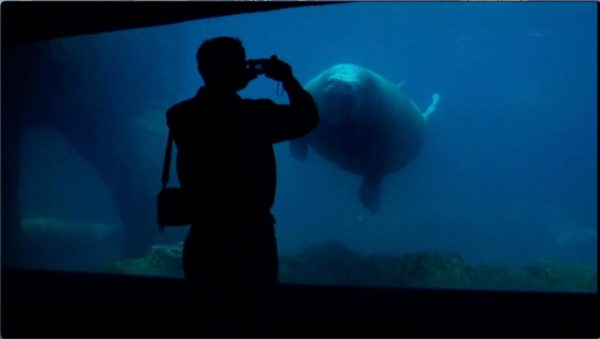 |
| Image of staged human-animal encounter as consumable visual pleasure. “The Aquarium” (United States, 2006; dir. Pawał Wojtasik). |
In an article in Film Quarterly, experimental film historian Scott MacDonald calls “The Aquarium” one of Wojtasik’s “more directly polemical” works through its focus “on how aquariums contribute to the illusion that environmental damage to the world’s oceans is of minor importance.” Pristine images of Edenic fantasies perpetuate inaction and resistance to collective accountability.
Human devastation, sea-level rise, overfishing, and acidification of the oceans and seas remains largely out of view. Crustaceans, fish, mammals, mollusks, and sea plants — which humans and other animals eat — consume microplastics floating in the ocean.
Wojtasik’s “The Aquarium” offers an alternative vision and epistemology for considering the entanglements between humans and animals.
Aquariums and Gentrification of Twice-dispossessed Lands
Wojtasik came to filmmaking later in life, after working a variety of manual labor jobs in carpentry and painting, and then training as a painter at Yale University’s MFA program. He studied Buddhism and meditation in Vermont. His experimental videos dive into the entanglements of consumerist cultures and unresolved environmental problems.
In an interview with MacDonald, Wojtasik describes his mother’s fascination with conspicuous abundance of products at supermarkets after they immigrated from Poland via Tunisia to the United States in the early 1970s.
He filmed the shelves and saw only future trash, speculating on the possible planetary consequences of cheap products, excessive packaging in single-use plastics, and other consumerist practices foreign to his childhood under Communism and Catholicism.
“The Aquarium” is a collaboration between Wojtasik and nonfiction writer Ginger Strand. Her 2005 article “Why Look at Fish?” inspired the video and provides a skeptical analysis of the aquarium boom in the United States. Aquariums are situated alongside shopping malls as “urban renewal.” Strand observes the artificial entanglements of human and nonhuman lives where renewal erases urban decay.
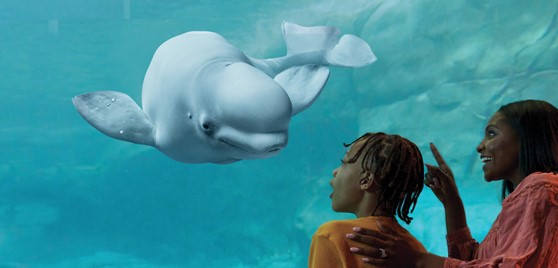 |
|
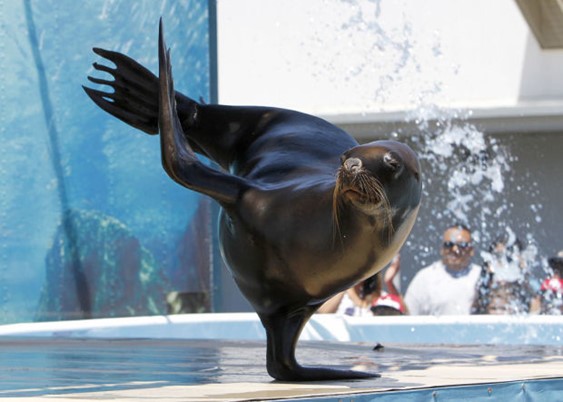 |
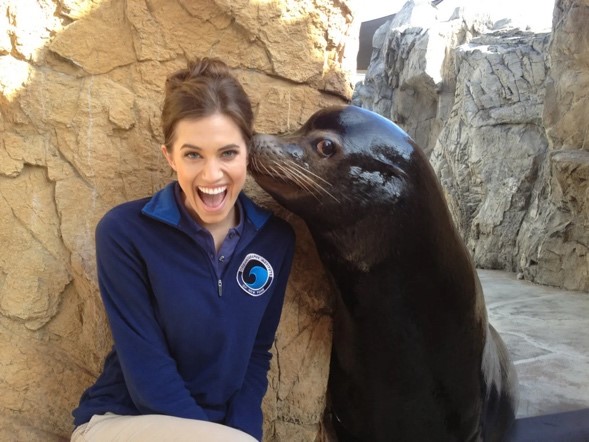 |
| Captive beluga whales and sea lions in marine park promotion. | |
In the United States, cities occupy lands stolen from Indigenous peoples. After White flight to the newly developed suburbs in the 1950s and 1960s, urban neighborhoods were ignored and associated with social decay. Gentrification and development of middle-class entertainments, such as aquariums, now dispossesses Black, immigrant, Latinx, and working-class communities like Indigenous ones before them.
These aquariums camouflage violent displacements of humans and relocations of animals from their natural habitats. The aquariums that Strand examines constitute another human-invented entanglement, hoisted onto animals, in “massive public-private endeavors.” Strand debunks the alleged educational value of zoos and aquariums. Instead, she examines human activity’s devastating impact on the oceans and marine life — all evident in the Wojtasik video.
Corporate Greenwashing as Restitution?
“The Aquarium” rejects the conventions of promotional videos for marine parks that showcase happy families, marveling at marine life in artificial environments.
At the SeaWorld parks in California, Florida, and Texas, as well as Gold Coast (Australia) and soon Abu Dhabi (UAE), marine animals perform demeaning tricks for human amusement. According to Whale and Dolphin Conservation: “SeaWorld holds 19 orcas in its three parks in the United States. At least forty-three orcas have died at SeaWorld.”
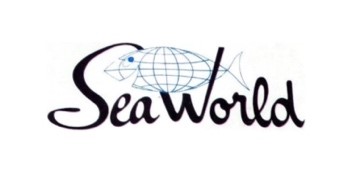 |
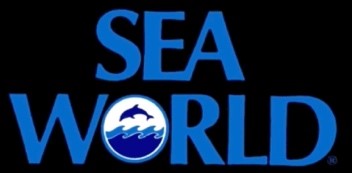 |
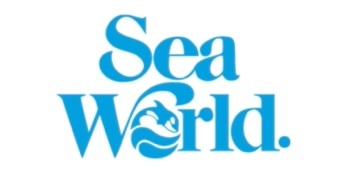 |
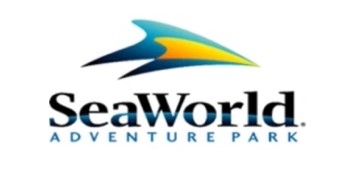 |
| Increasing camouflaging of animal captivity in SeaWorld logos across the decades. | |||
“Ecologically adept and technologically brilliant, the aquarium is a twenty-first-century utopia, a place where culture and nature unite to induce wonder,” Strand writes. “Publicity photos offered by aquariums make this clear. They have evolved a standard vocabulary of awe and absorption to indicate the new heights of sensation achieved in this artificial world.”
The emotional abuse of intra-mammal slavery appears in feature-length documentaries such as “Blackfish” (United States, 2013; dir. Gabriela Cowperthwaite), about an orca named Tilikum who eventually killed three humans. The “Free Willy” franchise (United States, 1993–2010; cr. Keith A. Walker) offers fantasies that orcas need humans to save them from other humans, a logic replicating classical colonial fantasies.
Wojtasik’s video offers a different perspective where humans are not figured as potential victims or saviors of animals. As humans observe them through thick glass, sea lions and beluga whales swim in tanks.
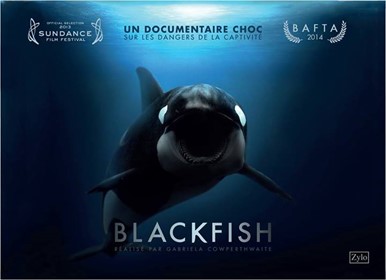 |
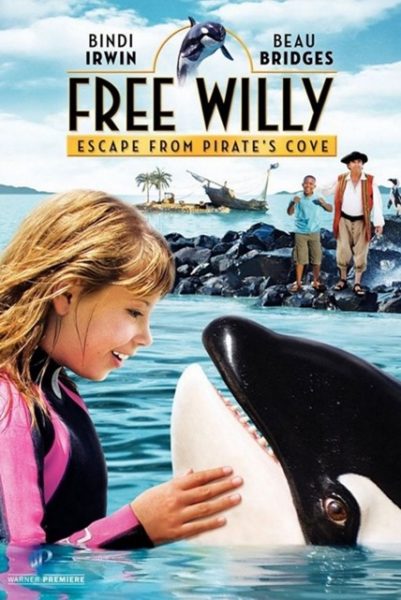 |
| Promotional materials for “Blackfish” and “Free Willy: Escape from Private’s Cove.” | |
“The Aquarium” opens with pristine images of Alaskan nature. An ambiguously ominous low humming dominates the soundtrack. After shots of clouds, ice, mist, mountains, sunrise, and water in an area called Resurrection Bay, near Suungaaciq (renamed Prince William Sound by settler colonizers), the film shifts to the interior of the Alaska SeaLife Center aquarium constructed by the Exxon Corporation.
According to Lila Guterman in a 2009 Science article called “Exxon Valdez Turns 20,” the Exxon Valdez oil supertanker hit Blight Reef in 1989, causing one of the worst human-made environmental disasters in history. The spilled oil killed an estimated 250,000 seabirds, 2800 sea otters, 200 harbor seals, 22 orcas, and an unknown number of fish eggs. The long-term damage remains unknown. Two decades after the spill, bald eagles, cormorants, salmon, and river otters had recovered, but herring, orcas, and sea otters had not.
The Alaska SeaLife Center aquarium is corporate greenwashing. Politicians accepted it as adequate restitution. Exxon also lobbied the United States “to sink U.S. participation in the Kyoto Protocol on global warming, a goal met in March 2001 with President Bush’s scrapping of the accord.” Strand notes that the sea lions in the aquarium eat herring no longer found in the sound due to the spill’s environmental damage.
Wojtasik’s video includes scenes photographed in aquariums in Mystic, Connecticut, and Brooklyn, New York, shot through the observational glass windows. By refusing to minimize the aquarium’s walls, he rejects the spectacle of captured sea lions and beluga whales swimming as though in nature
Entanglements of Sound and Image in Environmentalist Media
After the initial shot of the full bodies of the sea lions, the camera’s framing in “The Aquarium” changes. Only parts of each sea lion can be seen. The state of captivity becomes the primary focus, as the sea lions swim in tight circles, biting their hind fins, in glass cages. Beluga whale sit in isolated tanks.
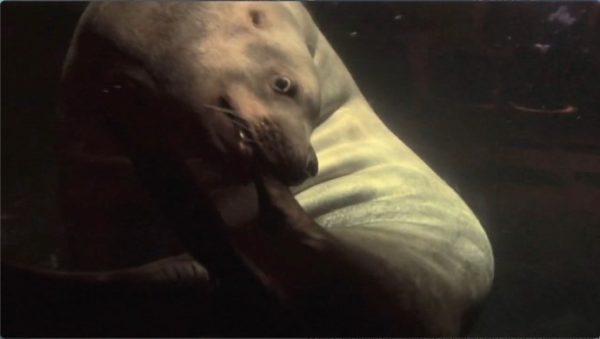 |
 |
| Sea lions and buluga whales held captive in Alaska SeaLife Center aquarium. “The Aquarium” (United States, 2006; dir. Pawał Wojtasik). | |
The shots that follow show humans taking photos with their phones. Human chatter infuses the soundtrack and their reflections float on the glass. However, the result is a voyeuristic spectacle of sea lions in human captivity rather than a multispecies community based on mutual respect.
Performance artist Kyle DeCamp reads the dates various aquariums and science museums were established. She offers a haunting history of U.S. imperialism over marine life.
As electronic music plays under her voice, DeCamp describes the status of the world’s reefs either threatened or in deterioration. She lists the human-bestowed names given to animals and the dangers to beluga whales.
Images of beluga whales in small tanks visualize human violence. A whale swims nears a window reflecting an onlooker. The image invokes the human imprint over the nonhuman world. Emphasizing a human preoccupation with ready-made observational pleasures, it visualizes human indifference to the pain of captive marine life.
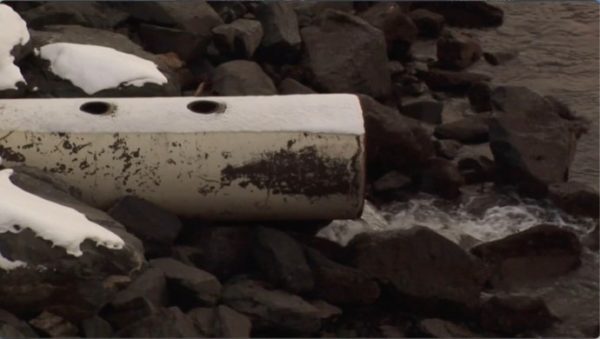 |
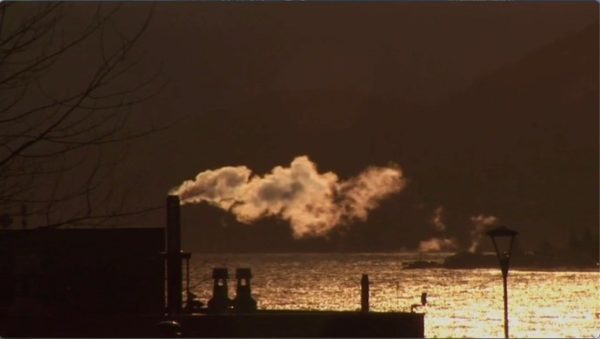 |
| Mysterious water emptied into the bay, mysterious steam or smoke emptied into the air. “The Aquarium” (United States, 2006; dir. Pawał Wojtasik). | |
As the voiceover lists toxins in seas and oceans, the entanglements of human and nonhuman cohabitants unfurl. Shots of the exterior beyond the aquarium document a pipe emptying into the bay. Images of buildings with steam- or smoke-emitting chimneys follow. The next shots return to the interior artificial human-made environments.
At other points, the voiceover parodies corporate promotions of marine life for human consumption. It lists books about fish and marine mammals for children where animal cuteness camouflages human violence. Over images of the surface of the water, the voiceover style evokes public-address announcements. It cautions humans to protect themselves from water splashing or directing their attention to particular captive animals.
The interplay of voiceover and images pulls into focus visible and invisible human violence upon marine animals that require reflection beyond corporate media’s anthropocentric frameworks of animals. A beluga whale approaches the window and then spins in the water. The average lifespan of beluga whales is 25 to 30 years in the wild, but only seven in captivity.
Rejecting Animals as Aestheticized Objects of Wonder
A 2006 review of “The Aquarium” in Artforum invites viewers to aestheticize the marine animals, suggesting that the “voice-over rattles off a litany of data” and functions “more as background noise” while “the images themselves approach abstraction.” The reviewer praises Wojtasik for avoiding “a tone of moral authority.”
This Artforum review echoes social acculturation to idyllic and apolitical representation of animals. As John Berger notes in “Why Look at Animals?,” the preferred human way of seeing animals is in the wild. Representation of animals, then, must recreate the illusion that they still live in their native habitats.
In An Introduction to Animals and Visual Culture (2012), Randy Malamud argues that humans need to deconstruct such cultural frames inside of which “animals have been placed (painted, written, construed, digitized, arranged, stuffed, chained, trained, dissected, imagined) with an iron-fisted sense of entitlement and control” by humans.
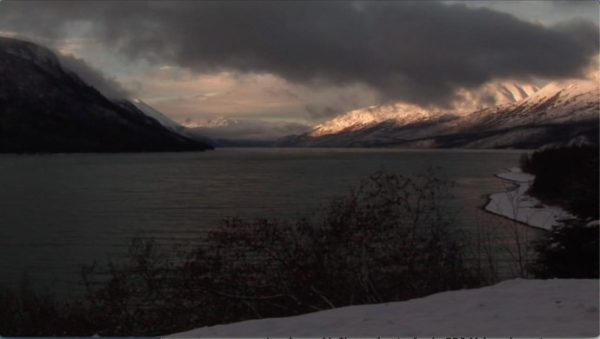 |
 |
| Image of Resurrection Bay with human instrusions effaced after Exxon Valdez oil spill and image of human-animal entanglements in Alaska SeaLife Center aquarium. “The Aquarium” (United States, 2006; dir. Pawał Wojtasik). | |
“The Aquarium” counters animals as aesthetic wonder. It features sounds of whales communicating with one another intermingled with electronic music into an evocative, incomprehensible language. The female voice shares: “Dangers to beluga whales: habitat alteration by dams, reduction of food sources through commercial fishing, reduction of food sources through pollution, noise disturbance from commercial human activity.”
The voiceover deconstructs state-sanctioned corporate greenwashing. It lists marine animals as “endangered resources that can be seen at the Alaska SeaLife Center, an aquarium built by Exxon as part of the reparation for the Exxon Valdez oil spill.”
In one of the “The Aquarium’s” final images, latex-gloved human hands pull an octopus from a tank. They struggle to disentangle from the octopus’s grip. The latex gloves signal that aggressive direct contact is potentially dangerous to both human and nonhuman — and that instead, humans must embrace other forms of entanglement.
“The Aquarium” and other videos by Pawał Wojtasik are distributed by Video Data Bank.
Dale Hudson is an associate professor at New York University Abu Dhabi. His research and teaching focus on environmentalism and on film and visual media in Southwest Asia, North Africa, and South Asia. He is co-author of “Thinking through Digital Media: Transnational Environments and Locative Places” (2015), author of “Vampires, Race, and Transnational Hollywoods” (2017), and co-editor of a double issue of “Middle East Journal of Culture and Communication” on “Film and Visual Media in the Gulf” (2021). He programs exhibitions for the Finger Lakes Environmental Film Festival (FLEFF) and coordinates Films from the Gulf for the Middle East Studies Association (MESA) Film Festival.

